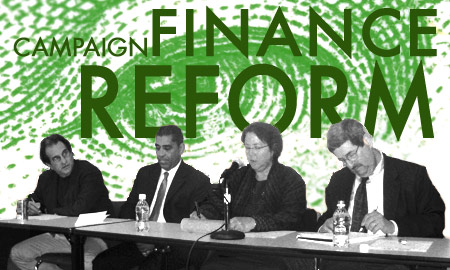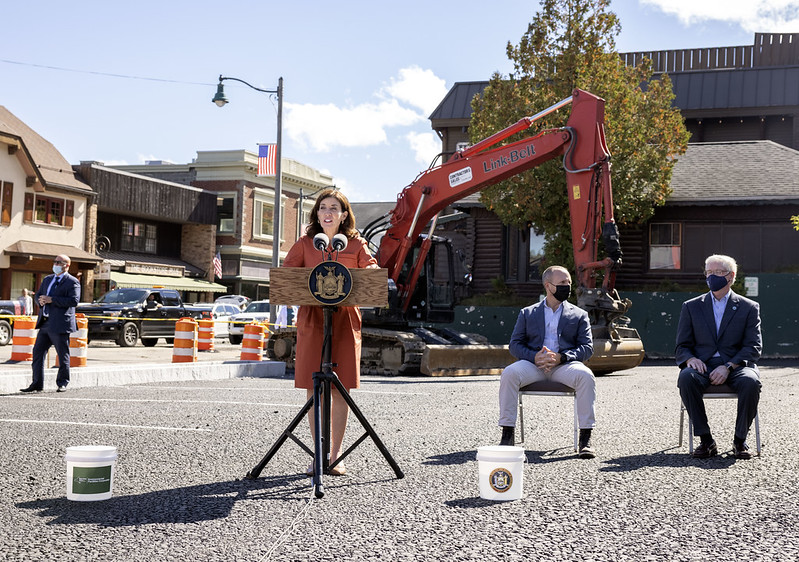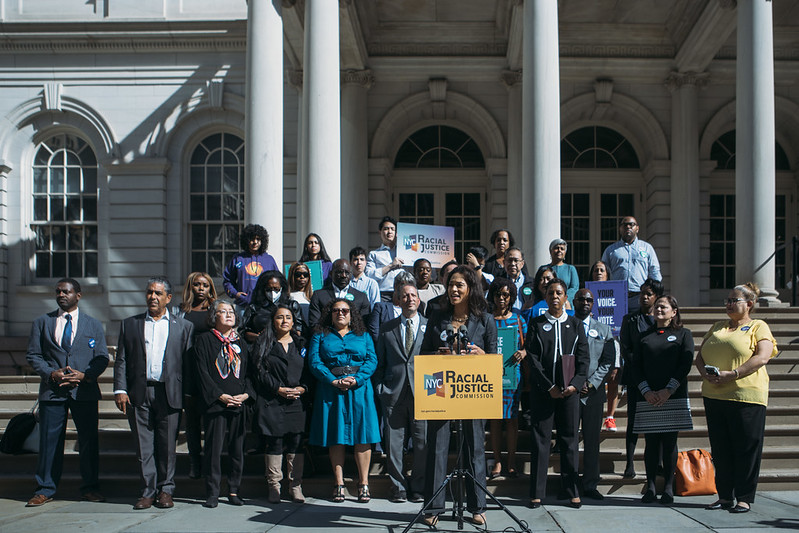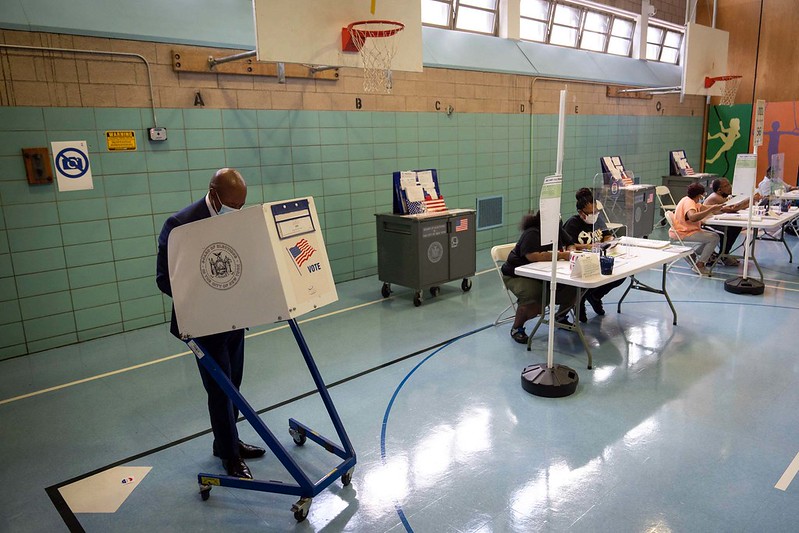It's the Economy
Not to long ago it seemed immigration would play a key role in this year's presidential campaign. But the hot-button issue has faded into the background since the economy emerged to trump everything else.
The economy also dominates news in much of the immigrant press as it does in mainstream media. Immigrants will feel the pain spreading throughout society, Larry Tung reports, but the suffering will fall particularly hard on some people who are not citizens or who work in construction or have low-levels jobs in service industries.
This month's Citizen looks at the recession's effects on various immigrant communities and workers. We also present some last-minute stories on the presidential campaign, as well as articles on a court ruling on restaurant delivery workers, Hindu-Muslim marriages, the fate of an East Harlem market and more from the Spanish, Chinese, Russian and Polish language press, via our partner Voices that Must Be Heard.
Polish Workers Fear Job Losses Super Express
The troubled economy has taken a heavy toll on construction jobs, creating less work for many Polish New Yorkers. There are fewer jobs in the building trades, and those that remain offer fewer hours or lower pay.
Food Crisis Affects New York's Children El Diario/La Prensa
A new study documents one effect of the economic turmoil is having on low-income people in New York, particularly children.
Despite Flagging Economy, New York's Haitians Seek to Help Hurricane Victims Haitian Times
Campaign Offers Little Discussion of Immigration Caribbean Life
Because the third presidential debate focused on domestic issues and took place on Long Island, where immigration has been a controversial topic, many observers thought the candidates would finally talk about immigration. They did not. Advocates discuss why.
Churches Walk a Fine Line on the Election Carib News
Many ministers with West Indian congregations support Barack Obama for president -- but they can't come out and say so.
Court Decision on Pay Alarms Restaurant Owners World Journal
Chinese restaurant owners reacted with shock and dismay to a court's decision that Manhattan's Saigon Grill restaurant chain must pay 36 Chinese deliverymen a total of $4.6 million in back wages and damages.
What Union Membership Means to New York Latinos El Diario/La Prensa
Some 300,000 Latinos in New York belong to labor unions. A study investigates what unions mean for these workers.
Upstate Towns Seek Immigrant Doctors Novoye Russkoye Slovo
At a recent job fair, upstate communities served refreshments, touted their recreational opportunities and offered pictures of scenic landscapes -- all in an effort to convince immigrant doctors to leave the city and practice in New York's rural areas.
Some in Greenpoint Oppose Bike Lane Nowy Dziennik/Polish Daily News
Thousands of cyclists in Brooklyn are cheering the prospect of a 1.5 mile greenway that would go from Greenpoint to Sunset Park, but some community residents say the area already has enough bike lanes.
Fallout from Tainted Milk Scandal Reaches Chinatown World Journal
Since melamine was found in Chinese milk products and animal feed, New York's health inspectors have stepped up their scrutiny of Chinese products.
Plans for East Harlem Market Fade Latin Week NY
For years, residents, merchants and city officials have talked of revitalizing the La Marqueta marketplace, but now all efforts seem stalled.
Bangladeshi Community Sees Rise in Hindu-Muslim Marriages Weekly Thikana
Interfaith marriages were once a rarity in the Bangladeshi community, but in this country, where sexes and religions mix freely, they have become increasingly common.
Â
Amid Economic Turmoil, the Candidates Talk Taxes

In the short run, local politics in the next few weeks may well have more effect on individual New Yorkers and the city's budget than November's presidential and congressional elections. Because the city must keep its budget balanced, it will have to deal almost immediately with the current financial and economic turmoil. For now, though, the mayor's push to extend term limits has obscured a full discussion of the city's tax and spending options.
Nevertheless, proposals in the U.S. Senate and House of Representative, as well as those from the McCain and Obama campaigns, make it clear that there may well be significant changes in federal tax and spending priorities that will affect New York. The most immediate revolve around short-term Democratic economic stimulus programs that could be implemented soon after the elections.
In the longer term, the McCain and Obama campaigns have spelled out, particularly on the tax side, unusually detailed descriptions of what their administrations would pursue in 2009 and beyond. They provide a rare look at - and debate about -- basic conservative and progressive policies in the 21st century. Those campaign proposals that have been analyzed recently -- and new ones come out almost daily - provide an interesting context for New York City's own fiscal choices.
STIMULATING THE ECONOMY
The Center on Budget and Policy Priorities recently analyzed the state-by-state impact of three provisions in House and Senate economic-stimulus proposals introduced in late September: extended unemployment benefits, increased food stamp benefits and new resources for states in need of fiscal relief. These, according to the center, are "among the most highly 'stimulative' policies available to Congress, primarily because they concentrate relief on those most likely to spend the money quickly, pumping dollars into an economy that needs more demand."
Because of legislation enacted earlier this year, unemployment benefits have been extended by 13 weeks. The new proposals would extend benefits another seven weeks in all states, and in the case of states with unemployment over 6 percent, another 13 weeks, for a total of 20 additional weeks of benefits in those high-need states. The center estimates that 1.4 million unemployed Americans will lose their benefits through December 2008, including 70,426 in New York State -- unless the Congress agrees to the extensions.
A temporary increase in food stamp benefits - a program fully funded by the federal government - would help offset recent sharp increases in basic food prices for 28.6 million eligible Americans. The Senate proposal would raise benefits by 10 percent, or $5.2 billion. The House proposal would increase benefits by $2.6 billion.
The report notes that food stamp benefits, because they are spent immediately, generate economic activity, so that one additional dollar of food stamps turns into $1.73 in total economic stimulus. Thus the total economic impact would be about $10 billion for the Senate plan and $5 billion for the House proposal.
Over 2 million people in New York State would benefit from the Senate and House food stamp proposals. Food stamp funding in the state would increase by $346 million in the Senate plan and $175 million in the House plan. The estimated total economic stimulus effect of the two plans in New York would be $640 and $320 million, respectively.
A third provision of the congressional plans would temporarily increase the federal share of state Medicaid spending, thus helping states avert budget cuts or tax increases. The Senate would increase federal funding for the healthcare program for low-income people by $19.6 billion over the next 14 months, the House by $14.4 billion over the next 13 months.
New York State would be the biggest beneficiary of this idea, receiving $2.65 billion under the Senate proposal, $2.44 billion from the House version. Because the city pays a substantial share of the state's Medicaid spending, this new benefit would presumably help ease New York City's budget problems. (New York City's share of Medicaid spending is projected to exceed $5.6 billion this fiscal year.)
THE CANDIDATES' TAX CHANGES
It will take longer for New Yorkers to feel the effects of any new federal tax policy arising out of the November elections. Whoever is elected, though, some state residents will benefit and others will lose from changes in personal income, estate, capital gains, dividends and payroll taxes.
The 2001 and 2003 Bush tax cuts, which McCain would continue, are currently scheduled to expire at the end of 2010. The Center on Budget and Policy Priorities issued a report in March that calculated the cuts will total $3.8 trillion if they are extended through 2018.
The $3.8 trillion in income and estate tax benefits go overwhelmingly to wealthy taxpayers. Seventy-four percent of the gains -- $2.8 trillion -- go to the top 20 percent of taxpayers. Thirty-one percent of the benefits -- $1.2 trillion - go to the top 1 percent of taxpayers (those with annual incomes above $450,000 in 2008). In 2012 alone, with the extended tax cuts in full effect, the top 1 percent would get cuts totaling $109 billion, almost one third of total cuts that year, or $67,000, on average, for each household.
Any such extension would of course have similar consequences in New York State. An October 2006 study by Citizens for Tax Justice estimated that in the 2001 to 2010 period the wealthiest 1 percent of New Yorkers (with an average annual income nearly $2 million) will receive 48.3 percent of the tax cuts, an average of nearly $80,000 a year. The poorest 60 percent will get only 13.7 percent of the tax cuts over 10 years, averaging only $379 a year. Income Taxes
An Oct. 16 Citizens for Tax Justice report analyzes the most recent Obama and McCain campaign tax plans. Both campaigns have proposed large cuts in the personal income tax. McCain's plan would cost $489 billion in 2012, Obama's, $348 billion.
The candidates' personal income tax plans have quite different beneficiaries. "Obama's plan would give taxpayers in the bottom 60 percent of the income distribution a larger tax cut, on average, than McCain's plan ($1,044 vs. $823 in 2012)," according to the report, while "The average benefits for the richest 1 percent of taxpayers under McCain's plan would be 43 times as large as the average benefits for this group under Obama's plan."
This arises largely from the candidates' approaches to extending the existing Bush income tax cuts, plus their different additional tax-cut packages. For example, McCain would extend the Bush cuts for 100 percent of taxpayers, and Obama would extend them for over 97 percent of taxpayers.
In the Obama plan, those 2.6 percent of taxpayers who have taxable income of more than $200,000 (singles) or $250,000 (married couples) would lose their Bush tax cut. The top income tax rate would revert from the current 35 percent rate to 39.6, the rate during the Clinton administration. Thus the Obama plan on the tax cut extensions would cost less -- $146 billion - than McCain's plan, $216 billion in 2012.
But both candidates have proposed big additional income tax cuts. McCain's largest one is a so-called "alternative simplified" tax, which Citizens for Tax Justice says will cost $98 billion in 2012, with 58 percent of the benefit going to the richest 5 percent of taxpayers.
For his part, Obama proposes what he calls the Making Work Pay Credit. This is a $500 refund of Social Security taxes for each working person ($1,000 for a working couple). This would cost $65 billion in 2012, with over half of the benefit going to the poorest 60 percent of taxpayers. Obama would also exempt seniors with taxable income below $50,000 from income taxes.
Both candidates offer proposals on cutting the estate tax that Citizens for Tax Justice describes as "costly and regressive," only benefiting "people who inherit huge amounts of money." Both candidates would raise the amount of an estate that would be exempt from taxes -- Obama to $7.5 million for a couple, McCain to $10 million. McCain's plan, which would drop the estate tax rate from 45 percent to 15 percent, is much more expensive ($60 billion in 2012) than Obama's ($29 billion in 2012), which would establish a 45 percent rate.
Taxing Business
Both candidates plan cuts in the corporate tax. McCain would lower the current corporate tax rate from 35 percent to 25 percent. Obama would keep the 35 percent rate, but would introduce several new business tax cuts.
CTJ notes that its study of corporate tax liability from 2001 to 2003 found that, after factoring in loopholes, the average effective tax rate for 275 of the largest corporations was less than half the statutory rate of 35 percent. Nearly a third of those corporations paid no tax at all in at least one of those three years.
The report notes finally, "The best that can be said for either of these tax plans is that they might not be fully implemented." Given the economic turmoil, it says, "the next president -- whoever he is - could decide to significantly cut back on the portions of his proposals that are more targeted to the wealthy."
THE LOCAL PICTURE
New York City, with its own budget so dependent on tax revenues generated by Wall Street, faces a more immediate fiscal problem than the federal government does. Worrying about budget deficits doesn't seem to be a priority in Washington. In fact, any federal economic stimulus package will be funded by deficit spending. The federal government will borrow even more money to pay for it.
However, the city cannot do that. It must balance its budget despite declining tax revenues. In June, long before the financial meltdown on Wall Street and in the international financial marketplace, the city faced a deficit of $2.3 billion in fiscal 2010 (beginning July 1, 2009) and deficits averaging $5.1 billion in the next two years. Those deficits will be much bigger when the mayor proposes his modification in the city's financial plan in late October or November.
Despite the enormity of the city's problems -- and in contrast to the lively national debate about conservative vs. progressive tax and spending options -- New Yorkers heard very little public discussion about the options available to the mayor and City Council until Council Speaker Christine Quinn's comment in mid October. Absent the debate, the mayor has quietly pushed ahead with conservative actions and proposals. His initial response to the Wall Street crisis in late September was to repeat last year's mid-year modification and ask his agency heads to come up with spending cuts of 2.5 percent in the current fiscal year and 5 percent in the next fiscal year. This saved roughly $1 billion the first time.
What the mayor would do next if needed, given several comments he's made, is rescind the 7 percent property tax rate that has been in effect for two fiscal years. For the last half of this fiscal year (January 1 to June 30, 2009), this would increase property tax revenues by approximately $700 million. But that burden would hit every New York homeowner or renter (renters pay a substantial part of their landlord's property tax).
An alternative would be to increase the personal income tax rate. Mayors David Dinkins and Rudy Giuliani raised the rate on this more progressive tax in difficult times. Bloomberg did as well. In his November 2002 mid-year modification, he restored a top tax rate of 4.45 percent. That top rate is now 3.65 percent.
In a speech on Oct. 15, Quinn supported the idea of an income-tax increase. ""We'll need to look at personal income tax changes, and we need to consider other ideas," she said. So far, the mayor has not publicly taken a stand on this idea.
The elite group of 30 bankers, developers and other prominent New Yorkers who have publicly supported the mayor's rescinding of term limits would seem to be a perfect group to support the mayor and City Council in a progressive, share-the-sacrifice agenda that would balance the city's economic and budget needs with the needs of the city's residents.
Glenn Pasanen, who teaches political science at Lehman College, has been in charge of Gotham Gazette's finance topic page since 2001.Â
Tackling Campaign Finance Reform

In politics, it's all about the cash. And this year, as in most even-numbered years, New York State politics is awash in it, with candidates spending hundreds of thousands -- sometimes into the millions -- of dollars to win election to the state legislature.
Fueling a candidate's coffers, critics say, can buy the rich access to government the rest of us do not have. To remedy that, cities, states and the country have implemented varying types of campaign finance reform.
New York City has kept up with the trend. It has adopted public financing and, last year revised its law to increase public matching funds and limit contributions from those that do business with the city.
Of course, New York City has not addressed all the apparent inequities. The Supreme Court has prohibited limits on self-financing -- the justices equated spending one's own money with speech -- meaning a billionaire mayor can spend as much as he wants to win a third term. Recent reports say Mayor Michael Bloomberg could spend as much as $100 million in next year's mayoral contest, prompting some to call on him to voluntarily close his wallet.
New York State has not modified its campaign finance laws in 33 years. Individuals can give almost $56,000 to a candidate for governor, nearly $100,000 to a political party and an unlimited amount to party "housekeeping" accounts.
In an effort to address that, the State Assembly has put forth a proposal that would limit individual donations to $2,000 and include a public matching fund.
Gov. David Paterson has also proposed cutting contribution limits, though he is silent on public financing.
The State Senate, however, opposes any change.
With all of these options floating through the capitol, several experts surveyed the existing laws and how they could be changed at a forum held by Citizens Union -- the sister organization to Gotham Gazette's publisher. The following comments are adapted from the discussion at the forum.
Calculating the Shortcomings -- Blair Horner
What Reform Can Do -- Susan Lerner
How to Change New York -- Dan Cantor
Testing Different Approaches -- Michael Malbin
A Look at 'Corporate' Donations -- Adriano Espaillat
Calculating the Shortcomings
By Blair Horner
My job is to lay out the failings of the campaign finance system and the debate in Albany. To do that, I'm going to give you four numbers: 94,200; 200; less than 1 percent and -- the last is not really a number to the numerical concept -- unlimited.
One: 94,200 is the campaign contribution limit in New York law. The legal limit for our campaign contributions is $94,200 each and every year for the party of your choice. That money can be used to advance candidates under state law.
Two: 200 is the average number of fundraisers that occur in Albany during the legislative session -- 60 days a year, roughly 40 nights on average. They're not holding them for you to go up there. They're holding them for the people who write the $94,000 checks -- Albany's political elite.
Three: Less than 1 percent, that's the number of individuals in the state that write campaign contribution checks in a year. One percent of individuals whip out their checkbooks and make a campaign contribution.
Four: It's the concept of soft money. You say, "I gave $94,200, but I want to give more." Under New York state law you can give more. It's called "soft money." And just to show that lawmakers have a sense of humor, they call it the "housekeeping account." You think of somebody vacuuming or dusting, but it's really a gigantic loophole.
Those four numbers give you a flavor of how we view the campaign finance system. It's a system designed around "pay to play." It's about big donors writing big checks to lawmakers under the assumption that the favor will be returned during the legislative or regulatory process. That's at the heart of what's wrong.
To add insult to injury, New York doesn't have very good system of disclosing information about the finance system. It is riddled with loopholes so that, for example, you can create multiple limited liability corporations that can give as much money as an individual can. The last part of the insult is pathetic and riddled with loopholes. The rules are, for all intents and purposes, not enforced.
We should demand higher ethical behavior. In New York, for example, people can use campaign contributions for their own personal expenditures. If you're a legislator, you can legally use your campaign contributions to subsidize your lifestyle - lease a luxury car, pay for country club memberships, go for trips abroad. The money from interest groups goes to a legislator, who frequently has no opponent. And so that money is basically pocketed.
A more ethical system would deal with those kinds of issues, because the public needs to see not only participation, but also a confidence that the laws are fair and are being enforced.
This system has been in place for a long time, and it has profound impacts. For example, the public is denied competitive elections. Since 1982, 35 incumbents have been beaten in the general election -- that's in roughly 2,500 races. Campaign finance also has an impact on public policy because big donors don't give big money because they feel charitable. This is American capitalism, people expect something in return, and sadly I think they get it.
Blair Horner is legislative director of the New York Public Interest Research Group.
What Reform Can Do
By Susan Lerner
What are we trying to achieve concerning campaign finance? Here are some of the things that people talk about. Each one -- however you order this list and what you leave off this list -- has a very important impact on what you have to choose for the campaign finance system.
One possibility is that you open the ballot to a greater pool of candidates. Reform can provide people without personal wealth or without wealthy friends or access to a lot of money the ability to compete for private office.
It can encourage broader participation in support of candidates, increase competition for office, with more people running. It could level the playing field among candidates; free candidates from constant fundraising; emphasize the role of individual voters, rather than special interests and corporate interests -- organized people, not organized money; and let more viewpoints reach the voters, because candidates have the ability to get their word out more effectively.
If you emphasize opening the ballot to a greater pool of candidates and give those without personal wealth or wealthy friends an opportunity to run an effective campaign -- if that is your primary, or perhaps, your only goal -- then you are going to be inclined toward a matching fund system like the one that we have in New York City. These are found in several other cities around the country and in just a very few states that adopted their campaign finance programs about 20 years ago, about the time New York City adopted theirs, because a matching funds system was sort of the campaign finance reform idea du jour.
Now if you are looking to increase competition for offices, free candidates from constant fundraising or lessen the impact of campaign money on public policy, then you tend to advocate what we call "clean money" or "clean elections." That's the more current fashion du jour. It is what we have in Arizona, Maine, now Connecticut, a pilot project in New Jersey and in North Carolina for judicial and for down-ticket state-wide races.
Clean money is a system where you qualify to run by collecting a set number of $5, or in some cases $10 donations -- never more than $100 -- from a certain number of people in the district in which you're running. You don't collect more, you don't collect less, and once you have sufficient money to qualify, you get a block grant. Everybody who qualifies gets the same amount of money. If you're outspent, you get what we call Fair Fight Funds, which are matching funds.
In Arizona, this is funded primarily through a surcharge on civil and criminal penalties. It comes out of a general fund in Maine, and they have a tax check-off for judicial races in North Carolina.
So we need to think about what are we are trying to achieve. What are our policy goals? We need to get some clarity on that and then work backward to help us shape what we should use for the right public funding system.
Susan Lerner is eexecutive director of Common Cause/NY
How to Change New York
By Dan Cantor
The goal of campaign finance reform here is less about getting private money out -- I don't think that will ever happen -- than getting public money in. We want to reduce the advantage that the wealthy and the well connected have.
Let's build on the New York City system. It's not perfect but it's familiar. It's pretty good.
The introduction of the robust matching fund system has totally changed New York. Those of us who try to recruit people to run for public office can tell people who come out of a history of service to a community group or a union, "All you actually need to do is raise $17,000 and the city's going to write you a check for $90,000." If you can't raise $17,000, you probably shouldn't run for office.
The State Assembly, which has been pointed out, has a pretty good record on this. The Assembly has passed a good bill. The bill backed by Assembly Speaker Sheldon Silver is quite interesting. It's a hybrid that combines elements of New York City's "matching system" with the so-called "clean money system" that has passed in Maine and now Connecticut. The vast majority of the Senate Democrats are on record publicly in favor of that bill.
The reason we don't have public financing in New York State is because of the State Senate. It remains in Republican hands. There will be no campaign finance legislation in New York State as long as Republicans hold the State Senate.
Now once the Democrats get the State Senate that doesn't guarantee we will get it. Senate Democrats are desperate for the support of people like us, and so they're making promises now that we think we can enforce very early next year. We are trying to get them obligated to actually pass campaign finance, otherwise they will become hooked, like drug addicts, on the same finance cash that has hooked the Republicans for so many decades. The whole thing is getting it done early.
We also need some help with the governor, who despite his long-term commitment to campaign finance is singing the blues theses days: He can't do it, because public financing will cost too much.
Dan Cantor is the executive director of the Working Families Party.
Testing Different Approaches
By Michael Malbin
We have often heard it said that the goal of campaign finance reform should be to get big money out of politics. You cannot prevent determined rich people from spending their money to influence politics. You can regulate direct contributions, but not independent spending. As a result, I agree with the statement that you have to "forget about getting private money out of politics." But I do not agree that "the goal is (simply) to get public money in." Public money may be desirable, but it is a means. It's not an end.
When political scientists describe goals, we acknowledge the negative or preventive goals stated by courts: avoiding corruption or the appearance of corruption. But we typically look also at affirmative goals: competition, expanding the pool of candidates, and greater and more equal public participation.
Much of the Campaign Finance Institute's work over the past several years has involved exploring the expansion of participation. The idea was to ask whether we could promote equality by building up the base -- the small contributors -- instead of just squeezing down on the top.
This has been a good year for small donors, largely because of the candidacies of Barack Obama and Ron Paul. From those campaigns, some have gotten the idea that the Internet would solve everything. I disagree. Technology is important, but public policy has an important role to play.
As political scientists, we can specify goals, but we are agnostic about how to achieve them. Our work at the Campaign Finance Institute has involved looking at a series of states, using extensive survey research and data analysis, to see whether public policy really does or can make a difference.
In most states, campaign contributions come from a few donors at the top.
Minnesota is unusual (See chart here). Donors who give no more than $100 account for 45 percent of the money. Minnesota has 100 percent rebates of up to $50 for donors who give to publicly financed candidates -- ones who agree to limit expenditures in exchange for public money.
The New York distribution is not unusual (See slide). Donors who gave zero to $100 donors accounted for only about 2 percent of the money raised by state candidates in 2006; donors who gave an aggregate of $1,000 or more accounted for 40 percent, and nonparty organizations another 39 percent.
But we then asked this question: Can we make states like New York look like Minnesota? In some obvious ways, no, but are the differences just a matter of political culture and background?
So we went ahead and modeled three different kinds of reforms, testing each one for its impact separately and in combination.
First, we assumed lower contribution limits, hypothesizing a $2,000 limit per candidate. Second, we assumed public matching funds -- multiple matching like New York City's (See charts here).
Finally, we asked what would happen if you also enacted policies that would get more people to play -- those small donors giving less than $100? Suppose -- either because you put in a tax credit or a rebate for small donors -- you could get the percentage of people who contributed up to 3 percent? Less than 1 percent of New York's voting age population contributed to any candidates in the 2006 state election. The number in Minnesota was 5 percent. (See Charts)
It turns out that building up the bottom like this could have a huge impact. And public policy -- including rebates, tax credits or matching grants -- can be structured to help make this happen.
The key lessons are first, that policy choices can change the situation radically and, second, that there is more than one way to reach the same goal. So it is important, when you talk about campaign finance reform, to think about what it is you're trying to get to, not just what you're trying to get away from.
I would argue that one of the key goals is to get more people involved in the process. We know that getting more small donors involved also means more volunteers. There is two-way feedback between giving and doing. Getting people involved is valuable for its own sake, so it's important when formulating campaign finance policy to think carefully about how best to encourage this goal.
Michael Malbin is executive director of the Campaign Finance Institute and professor of American politics at Rockefeller College, University at Albany
A Look at 'Corporate' Donations
By Adriano Espaillat
I will speak to you from the perspective of a consumer, since I have benefited from public campaign financing. In 2005, I probably wouldn't have been able to run for the borough presidency without some public financing involved. I came out in the middle of about 10 candidates running. I raised about $600,000 and was able to get significant matching funds, and I think that made my candidacy a more competitive one.
I am a supporter of public financing and am a sponsor of the Assembly bill that has been passed. I hope that some day that will come to fruition at the state level as it has at the city level, where it has fostered and encouraged many folks to run for office and represent their communities.
One goal, of course, is to take soft money out of politics. Another one is to make the government more transparent and accessible to the general public. The public finance system here in New York City has accomplished some of that. If you take a look at the makeup of the City Council, it is more reflective of the composition of the city of New York. People who may not be rich or middle class are still able to raise some dollars and be competitive in a race and represent their communities.
In the effort to get hard-core money out of politics, there is a proposal to restrict campaign contributions. To most people, that means limiting contributions from pharmaceuticals and the big insurance companies and the people that have a vested interest in what happens in Albany and Washington. But what happens to the Korean fruit store who has a corporation and like many New Yorkers is not a citizen? One third of New Yorkers are foreign born. These people play by the rules, they pay taxes, they send their kids to public school, and they ride the subway. What happens to them? How do they get involved in the electoral process? How do they have an impact on who is going to represent them or the district where they have their stores?
Many of them choose to write a $500 check to a candidate. I don't see it as trouble that a Dominican bodega owner or a Jamaican beauty shop owner or a Korean fruit storeowner writes a corporate $500 check for me. I don't thing that's twisting my arm. I think it's very much part of America and that's granting access to government to people.
In all of this discussion, no one is talking about the rich people -- very rich people -- spending millions and millions of dollars to represent us. I just looked at the financial reports for congressional delegations in New York State and across the United States and the number of millionaires that represent us in Congress. Nobody has said a peep about millionaires and, in some cases billionaires spending lots and lots of money to represent us, but we may be restricting the Korean fruit storeowner, the Jamaican beauty storeowner or the Dominican bodega owner.
Adriano Espaillat, a Democrat, represents Manhattan's District 72 in the New York State Assembly. Â





